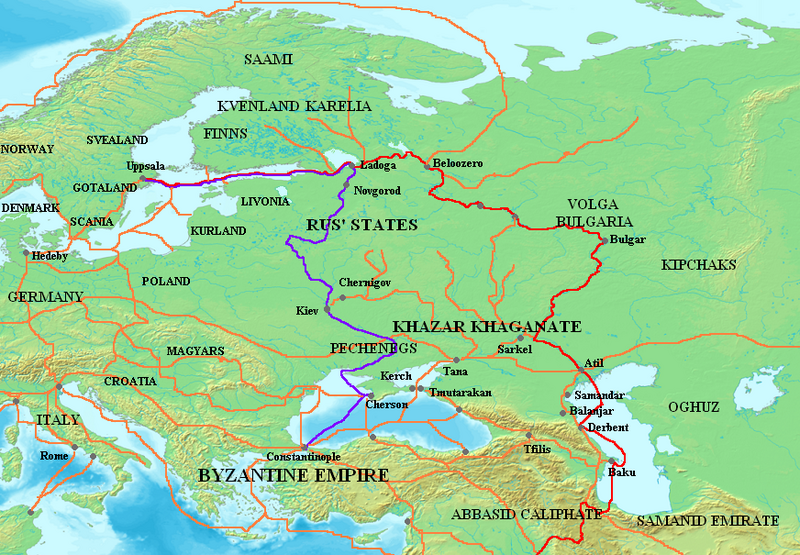File:Varangian routes.png
Appearance

Size of this preview: 800 × 555 pixels. Other resolutions: 320 × 222 pixels | 640 × 444 pixels | 872 × 605 pixels.
Original file (872 × 605 pixels, file size: 859 KB, MIME type: image/png)
File history
Click on a date/time to view the file as it appeared at that time.
| Date/Time | Thumbnail | Dimensions | User | Comment | |
|---|---|---|---|---|---|
| current | 11:29, 3 October 2023 |  | 872 × 605 (859 KB) | OrionNimrod | Restore original: "Wallachians" added by Romanian user, however it was no Wallachia in the 8-11th c: British historian, Martyn Rady - Nobility, land and service in medieval Hungary (p91–93): the sources before the 13th century do not contain references to Vlachs anywhere in Hungary and Transylvania or in Wallachia. Byzantine sources mentioned Vlachs all deep in the Balcan. Also map should make by academic historians not by personal POV. |
| 18:23, 16 August 2023 |  | 872 × 605 (799 KB) | Claude Zygiel | In one hand there are Byzantine sources which mention the Vlachs, secondly it is not because other sources do not mention them that they did not exist. In the other hand, the Hungarian theory which affirms that "the absence of proof is proof of absence", that this group disappeared for a thousand years, and that it would have been the only one, among all the peoples of the region , to not being able to cross the Balkans, the Danube and the Carpathians (while they were nomadic shepherds), is u... | |
| 10:54, 25 July 2023 |  | 872 × 605 (794 KB) | OrionNimrod | "Wallachians" added by Romanian user, however it was no Wallachia in the 8-11th c: British historian, Martyn Rady - Nobility, land and service in medieval Hungary (p91–93): the sources before the 13th century do not contain references to Vlachs anywhere in Hungary and Transylvania or in Wallachia | |
| 07:29, 26 June 2023 |  | 872 × 605 (799 KB) | Johannnes89 | Reverted to version as of 16:47, 18 April 2023 (UTC) crosswiki image spam, often containing historical inaccuracies | |
| 23:53, 25 June 2023 |  | 872 × 605 (1,017 KB) | Valdazleifr | Fixed minor errors | |
| 16:47, 18 April 2023 |  | 872 × 605 (799 KB) | Claude Zygiel | There was no Wallachia but Wallachians. The theory that speakers of Eastern Romance languages disappeared for a thousand years between 275 and 1300 is only supported by Hungarian nationalist authors. | |
| 12:41, 25 November 2022 |  | 872 × 605 (794 KB) | OrionNimrod | Reverted to version as of 15:59, 8 March 2009 (UTC) It was no Wallachia in the 8-11th century | |
| 12:44, 21 May 2015 |  | 872 × 605 (799 KB) | Spiridon Ion Cepleanu | Dvina & Wisla-Dnestr route, some details | |
| 15:59, 8 March 2009 |  | 872 × 605 (794 KB) | Mahahahaneapneap | Compressed | |
| 23:15, 18 January 2007 |  | 872 × 605 (859 KB) | Electionworld | {{ew|en|Briangotts}} == Summary == Map showing the major Varangian trade routes, the Volga trade route (in red) and the Trade Route from the Varangians to the Greeks (in purple). Other trade routes of the 8th-11th centuries shown in orange |
File usage
The following 36 pages use this file:
- Abbasid harem
- Atil
- Balanjar
- Black Sea slave trade
- Bukhara slave trade
- Bulgars
- Byzantine economy
- Crimea
- Danish slave trade
- Don–Volga portage
- Foreign trade of medieval Novgorod
- Greece runestones
- History of the western steppe
- Khazar slave trade
- Khazars
- Kievan Rus'
- Route from the Varangians to the Greeks
- Rus' people
- Samandar (city)
- Slavery in medieval Europe
- Swedish slave trade
- Trade during the Viking Age
- Varangian runestones
- Varangians
- Volga Bulgarian slave trade
- Volga trade route
- Volga–Don Canal
- Talk:Volga trade route
- User:Briangotts/maps
- User:Chaosdruid/documentsofinterest/Ukraine
- User:Falcaorib/Russia and Soviet Union
- User:Falcaorib/Ukraine
- User:Kazkaskazkasako/Books/History
- User:Осла/Києвска Рус
- Portal:Russia/Selected article
- Portal:Russia/Selected article/2
Global file usage
The following other wikis use this file:
- Usage on af.wikipedia.org
- Usage on ar.wikipedia.org
- Usage on ast.wikipedia.org
- Usage on az.wikipedia.org
- Usage on be-tarask.wikipedia.org
- Usage on be.wikipedia.org
- Usage on bg.wikipedia.org
- Usage on ca.wikipedia.org
- Usage on ckb.wikipedia.org
- Usage on cs.wikipedia.org
- Usage on cv.wikipedia.org
- Usage on cy.wikipedia.org
- Usage on de.wikipedia.org
- Usage on el.wikipedia.org
- Usage on en.wikibooks.org
- Usage on en.wiktionary.org
- Usage on es.wikipedia.org
View more global usage of this file.



